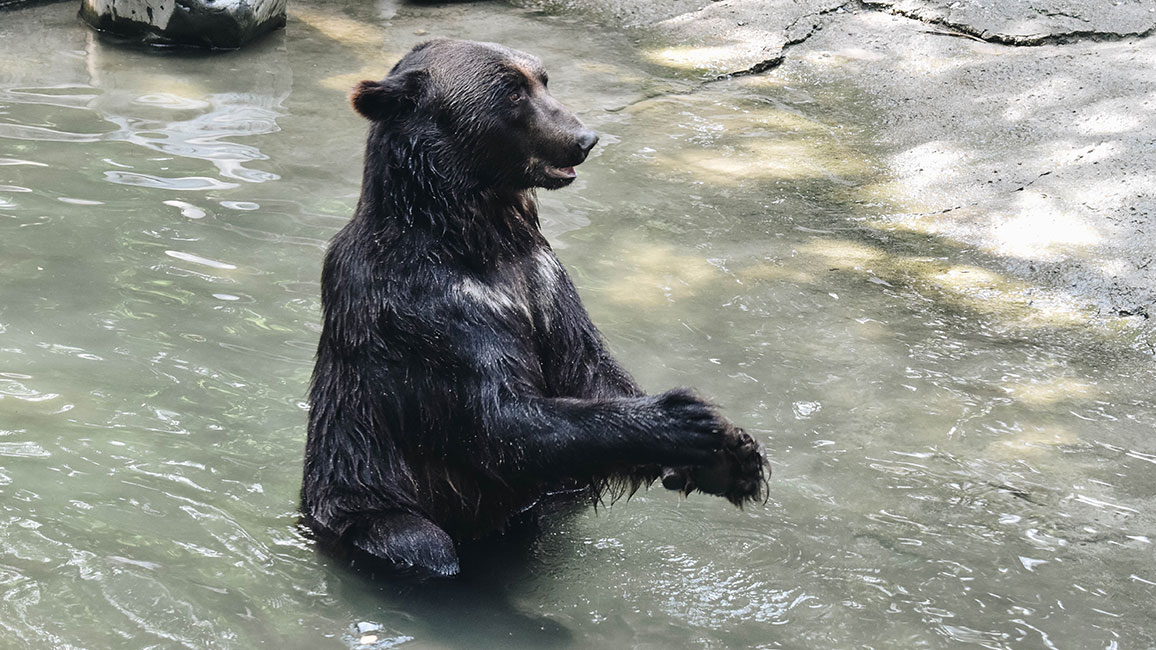
Black Bears
By Kate HofmannBlack bears have many talents. They can climb trees, stand tall on their hind legs, leap short distances, sprint at 30 miles per hour, and swim two miles at a time. But their best trick of all? It’s probably their ability to find good things to eat—anytime and anywhere.
Black bears are omnivores (OM-nuh-vores). That means they eat both animals and plants. You may think of bears as fierce predators, but much more of their diet comes from plants than from animals. From spring to summer to fall, black bears cruise the woodlands, hunting up all kinds of tasty treats. Let’s tag along through a bear’s year of eating and see what it’s gobbling up.
SWEET SUMMERTIME
When summer comes around, good food is everywhere. Fruit is a black bear favorite. Raspberries, blackberries, blueberries—so many flavors to choose from! But how do bears pick fruit without fingers? With nimble lips that can pluck berries one by one! Bears eat only the ripe ones and return after a few days for the next crop.
Honey is an even sweeter treat. Lucky for black bears, bee stings don’t bother them. Bears just devour the bees and their larvae, too! In fact, bears eat a lot of insects—not just bees but also ants (and their larvae), beetles (and their grubs), and caterpillars.
FALL FEASTING
Fall is when most black bears really get down to the business of eating. Their survival depends on bulking up for the winter in a big way. So when nuts and seeds ripen at the end of summer, black bears go nutty for them. Walnuts, hazelnuts, pine nuts, acorns, and others are all great for packing on the pounds. A black bear can gain as much as 20 to 30 pounds a week at this time of year.
TROUBLE WITH TWO-LEGGEDS
Black bears have terrific noses. They also have a good memory for where food can be found. But sometimes that talent hurts them. They can easily sniff out dumps, campgrounds, birdfeeders, and other places where people leave food. This is bad news for bears. They can’t help being tempted—but if people feel threatened, the bears may be killed.

A LONG WINTER NAP
In most places, black bears snooze away the coldest months. A bear crawls into a cave, tree hollow, or some other shelter. Then it goes into hibernation. Why? There’s not much food to be found in winter. And for an animal that spends most of its days eating as much as it can, that’s no time to be awake!
During hibernation, a black bear doesn’t eat, drink, or even go to the bathroom. Its heartbeart slows way down, and it burns fat for energy to keep its body warm. That means the sleepy bear loses weight all winter long. For mama bears, hibernation saps even more energy. Cubs are born during the winter—usually two or three of them per mama. Even though the mother bear isn’t eating, the babies must. Their mother feeds them with her rich milk, which is also made from her stored fat. The cubs grow quickly, playing and exploring in the den while their mother naps and tends to them. When warm weather returns, she wakes up skinny—and starving!
SPRING TRAINING
A hungry black bear gobbles up tender springtime green leaves and plant sprouts. But not much else is growing yet, so this is when a bear may hunt larger animals, including deer fawns and moose calves. It may also look for small animals such as frogs, crayfish, and rodents to round out its diet. And if the bear comes across roadkill or other dead animals, it may help itself. A black bear cub stays with its mother for about a year and a half. Mama Bear does her best to keep the cub safe as it learns what’s good to eat and where to find it. Before long, the cub is eating a little of all kinds of things—just as a black bear should!
“Black Bears” originally appeared in the August 2011 issue of Ranger Rick magazine.
(Click on each image above for a closer view of the story.)


















